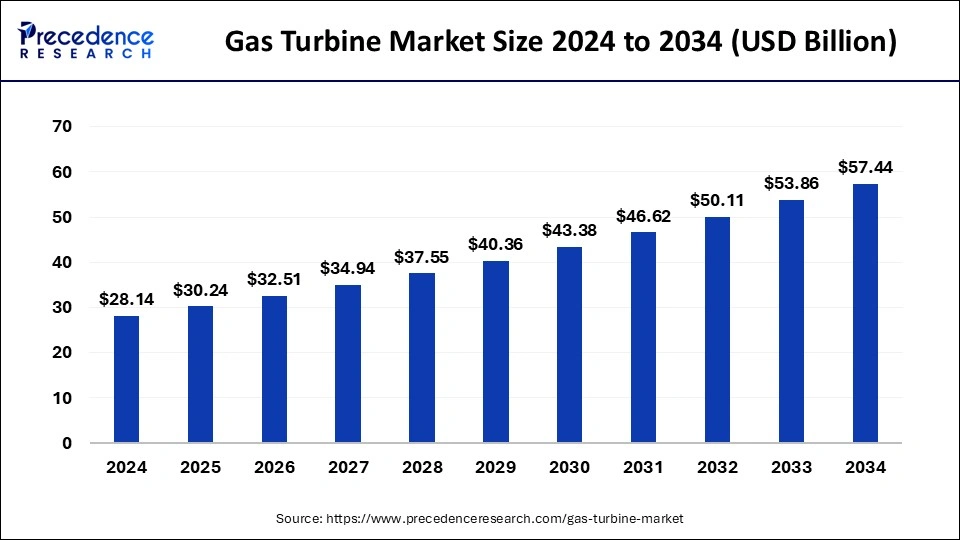The global gas turbine market valued at USD 28.14B in 2024, is expected to grow to USD 57.44B by 2034, registering a CAGR of 7.48%.
Gas Turbine Market Critical Observations
- Asia Pacific accounted for about 37% of total revenue in 2023.
- The >200 MW capacity segment captured 66% of the revenue share in 2023.
- Combined cycle turbines led the market with a 74% revenue share in 2023.
- The power & utility sector dominated with over 82% of the revenue share in 2023.
- The aero-derivative segment is projected to grow at a 9% CAGR from 2024 to 2033.

The global gas turbine market is expected to grow significantly from USD 28.14 billion in 2024 to USD 57.44 billion by 2034, driven by rising energy demands. Asia Pacific led the market in 2023, accounting for 37% of the total revenue. The >200 MW capacity segment made up 66% of the revenue, while combined cycle turbines dominated with a 74% share. Power & utility applications contributed over 82% of the revenue, highlighting the importance of gas turbines in energy production. The aero-derivative segment is projected to grow at a 9% CAGR between 2024 and 2033.
Sample Link: https://www.precedenceresearch.com/gas-turbine-market
Market Scope
| Report Highlights | Details |
| Market Size in 2023 | USD 26.18 Billion |
| Market Size in 2024 | USD 28.14 Billion |
| Market Size by 2034 | USD 53.67 Billion |
| Growth Rate from 2024 to 2034 | CAGR of 7.4% |
| Largest Market | North America |
| Fastest Growing Market | Asia Pacific |
| Base Year | 2023 |
| Forecast Period | 2024 to 2034 |
| Segments Covered | Product, Application, Technology, Capacity, Region |
| Regions Covered | North America, Europe, Asia-Pacific, Latin America, and Middle East & Africa |
Core Factors
The rising global demand for electricity, driven by increased consumption in regions like the U.S. and China, is fueling the growth of the gas turbine market. Gas turbines are essential for stabilizing power grids, especially when renewable sources like solar and wind are intermittent. The ongoing global population growth also contributes to higher energy needs, further driving demand for reliable power generation solutions. However, environmental concerns surrounding emissions from gas turbines, including greenhouse gases and pollutants, are restricting the market. Stricter regulations and the push for cleaner alternatives are challenging the growth of gas turbines.
Potentials
- Integration with renewable energy: Gas turbines can complement renewable sources like solar and wind, ensuring grid stability when renewable generation fluctuates.
- Technological advancements: Ongoing improvements in gas turbine efficiency and reduced emissions could open up new market opportunities.
- Growing demand for electricity: The global increase in energy consumption creates a rising need for efficient power generation technologies, including gas turbines.
- Advancements in natural gas extraction: Enhanced techniques like fracking make natural gas more accessible and cost-effective, boosting the adoption of gas turbines.
- Emerging markets: Rapid industrialization and urbanization in developing regions will increase the demand for reliable and scalable power solutions like gas turbines.
Obstacles
- Environmental concerns: Gas turbines produce greenhouse gases and other pollutants, which could limit their attractiveness in markets with stringent environmental regulations.
- Fluctuating natural gas prices: The cost of natural gas can vary, which impacts the financial viability of gas turbines in some markets.
- Regulatory pressures: Increasingly stringent regulations aimed at reducing emissions may drive up compliance costs or limit the use of gas turbines.
- Competition from renewable sources: As renewable energy technology continues to advance, it may reduce the demand for gas turbines as a backup power source.
- High upfront costs: The initial capital investment required for installing gas turbines can be a barrier, particularly in developing regions.
Regional Insights
The Asia Pacific gas turbine market, valued at USD 9.69 billion in 2023, is expected to grow significantly due to rapid infrastructure development and government support for cleaner energy. India and China are key players in this growth, with India increasing its focus on clean resources and China reducing its reliance on coal. The Middle East and Africa are also poised to see growth, driven by demand for gas-fired combined cycle plants. Meanwhile, the U.S. and Russia are expanding their gas-based power generation, pushing up global demand. However, the rise of renewable energy may pose challenges to gas turbine growth.
Don’t Miss Out: Liquid Biopsy Market
Industry Leaders
- Wartsila
- BHEL
- Mitsubishi Hitachi Power Systems
- Harbin Electric International Company
- Siemens AG
- Man Diesel & Turbo
- General Electric
Recent Insights
The gas turbine market is experiencing significant growth, with projections estimating a rise to USD 56.51 billion by 2034. This expansion is driven by increasing energy demands, stringent environmental regulations, and technological advancements. Hybrid systems, digitalization, and the global energy transition present substantial opportunities for market players. However, challenges such as environmental concerns and the rise of renewable energy sources may impact growth.
Market Segmentation
By Capacity Type
- > 500 kW to 1 MW
- > 1 MW to 30 MW
- < 50 kW
- 50 kW to 500 kW
- > 70 MW to 200 MW
- >30 MW to 70 MW
- > 200 MW
By Product Type
- Heavy Duty
- Aero-Derivative
By Technology Type
- Combined Cycle
- Open Cycle
By Application Type
- Process Plants
- Power Plants
- Oil & Gas
- Aviation
- Marine
- Others
